New Tech: 3DWearable Motion Tracking
There is no need to convince Slowtwitch readers of the importance of a bike fit and motion efficiency. So, we can skip the preamble in this profile of 3DWearable, a start-up that offers a system that combines motion tracking and analysis with real-time audio feedback.
Your bike fitter likely uses a range of metrics to dial in your fit with the goal of making you as efficient (and comfortable) as possible on the bike. Your bike fitter also likely teaches you how to pay attention to your body so that you can learn to feel what it is like to be moving optimally on the bike. This is not unlike what physical therapists refer to as neuro re-education. The process takes time, as you can likely attest to the adaptation phase after a new bike fit being correlated with how much your position changed.
The only problem is that as soon as the fitting session ends, you are left alone without the motion metrics and the bike fitter’s teaching to reinforce what you just learned about your body moving optimally with the new bike fit. Further, you become dependent on your bike fitter to set up each new bicycle you introduce to your stable.
Motion Tracking System
The team at 3D Wearable sets out to supplement that scenario by creating a system consisting of two motion sensors that communicate via Bluetooth to an app on your phone. The two motion sensors can map the baseline of any motion (i.e., pitch, yaw, roll, acceleration) on a landmark on the body and provide real-time audio feedback of that same motion within an adjustable tolerance.
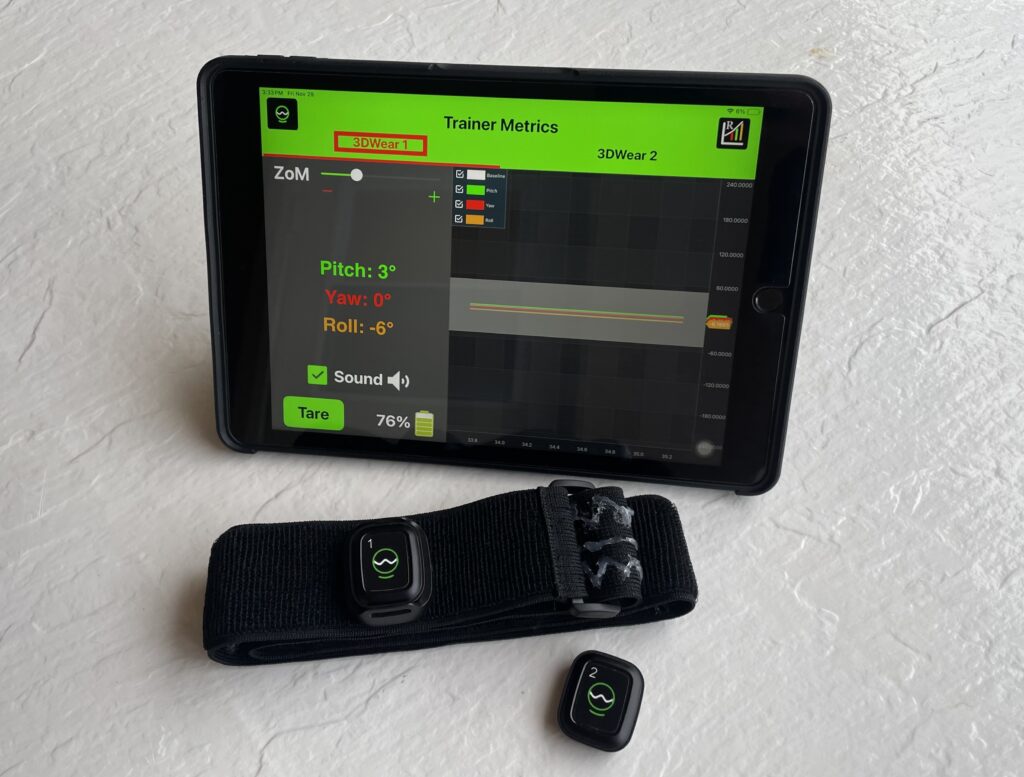
The simplest use case is saddle height. One of the motion sensors can be placed on your sacrum to locate your ideal saddle height and hip angle while pedaling. This motion can then be recorded as the ideal baseline. Then, while you are out on a ride you can receive audio feedback – a chime coming from your mobile phone – when you are outside a set degree of variance from the ideal motion.
As we fatigue, our ideal motion form is susceptible to deterioration, especially when it is a motion we are still training our nervous system to enact unconsciously. We get fatigued on a long ride, and we tend to hunch our back and roll our hips back. This then leads to compensation and potential for injury. The audio feedback from the 3DWearable system can help us correct our posture on the bike and prevent injury. It can also be an indicator that it is time to stop.
Training the Nervous System
As co-founder and long-time bike fitter, Eddie O’Dea, explained, we are constantly training our nervous system through repetition. Ideally, our training is reinforcing our bodies and nervous system to maintain an ideal motion for longer and longer durations of efficiency. As soon as we are falling outside a set range of an ideal motion, we are not only no longer reinforcing the ideal motion but also reinforcing a less efficient motion. We get tired and our bike posture (and running form) gets sloppy.
There is a very good chance we are all reinforcing less than ideal motion when stuck indoors logging hours on the trainer. I bet you can relate to moving your hands from the hoods to the bar tops, hunching your back, and rolling your hips backward late into an indoor endurance ride. Pay attention to it next long indoor ride, then imagine having audio feedback to remind you of when your posture on the bike is getting lazy. And then, consider the over-use injuries from compensation you would be avoiding.
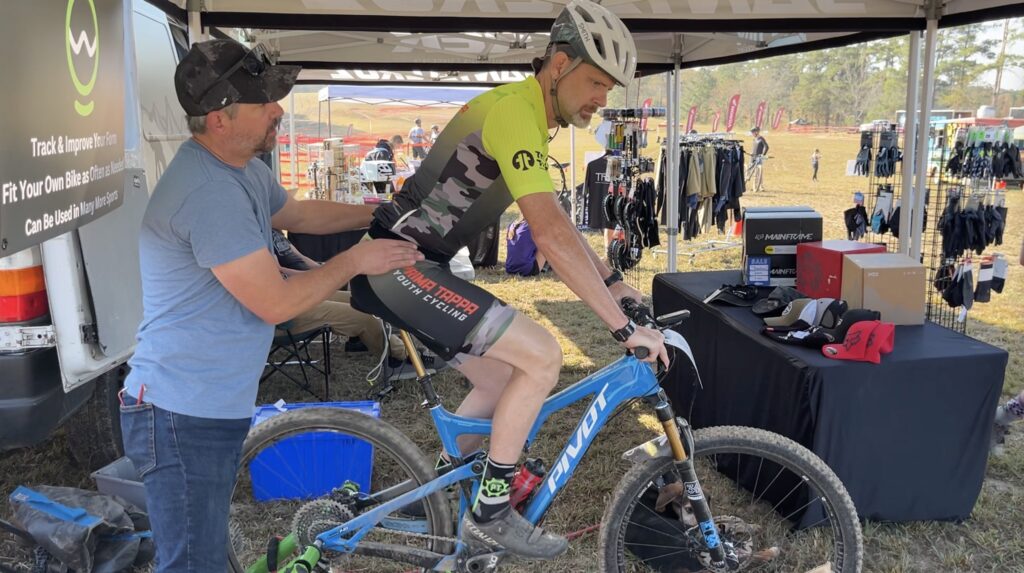
Eddie went on to explain that the neuro re-education phase is accelerated with the audio feedback from the sensors. The chimes from the 3DWearable app allow athletes to practice the motion outside the lab or fitting studio where many other variables are at play. Newcomers to a sport or activity benefit from a wider tolerance variation as they are making far greater adjustments to their motion toward the ideal. Highly specialized, veterans of a sport of activity benefit from a tighter tolerance variation as they are seeking out small margins of improvement on already very efficient motions.
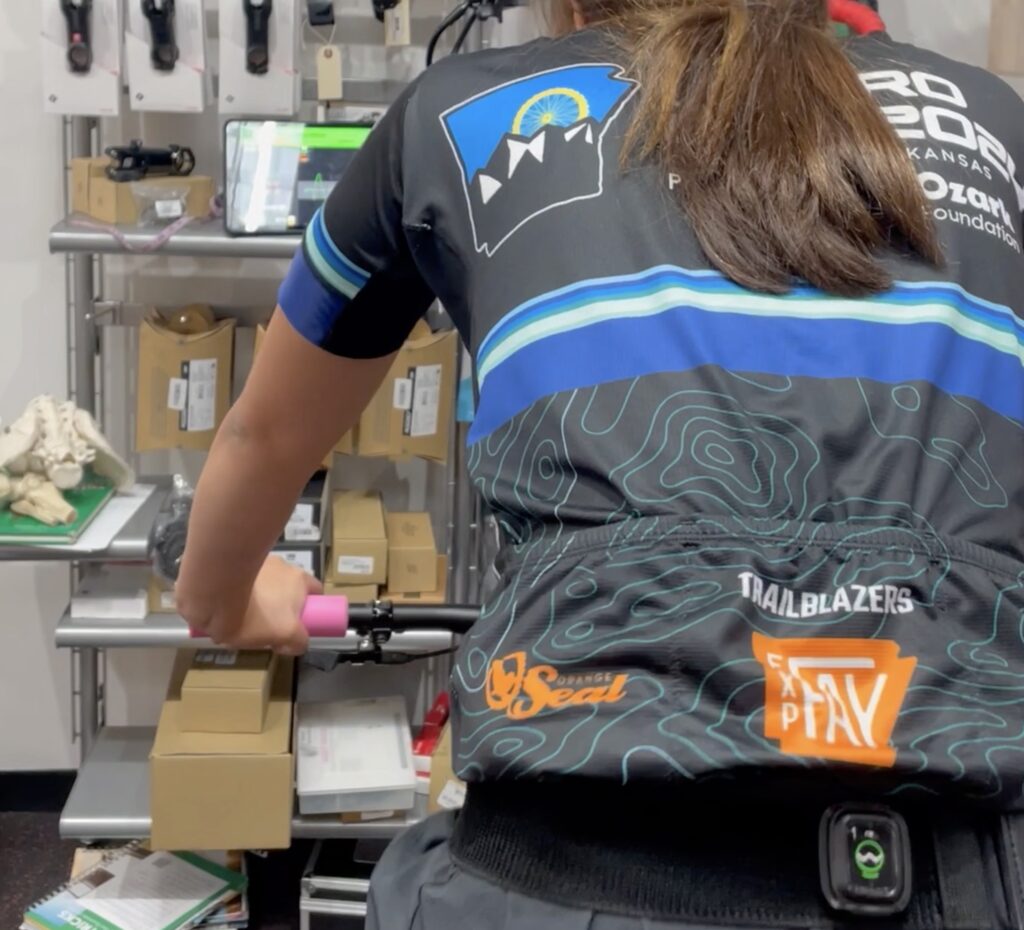
Eddie O’Dea has been in the bike fitting game for a long time, and I trust him when he tells me that the 3DWearable system has changed the way he approaches bike fits. Eddie first fit me and my team in 2006 alongside 3DWearable co-founder Tom Coleman. And, Eddie was my go to bike fitter years later when I lived in Atlanta. Eddie and Tom are driven by the desire to get more people moving more efficiently and with less injury. They invented the 3DWearable system to both extend the value of the bike fit out on to the road in real-time training and to equip the end user with tools and knowledge to refine their own motion.
Increased Variables
Eddie went on to explain that the more sensors that are introduced to the system, the complexity of the number of motions and the relationships among them grows exponentially. Eddie foresees being able to map baseline motions for additional variables experienced outside on open roads. This means that the sensors on the body are not only tracking their relative position (i.e., pitch, yaw, roll) for hip angle and cadence (as examples), but also doing so in relationship to the speed of the bike and the angle of the bike on the road’s grade.
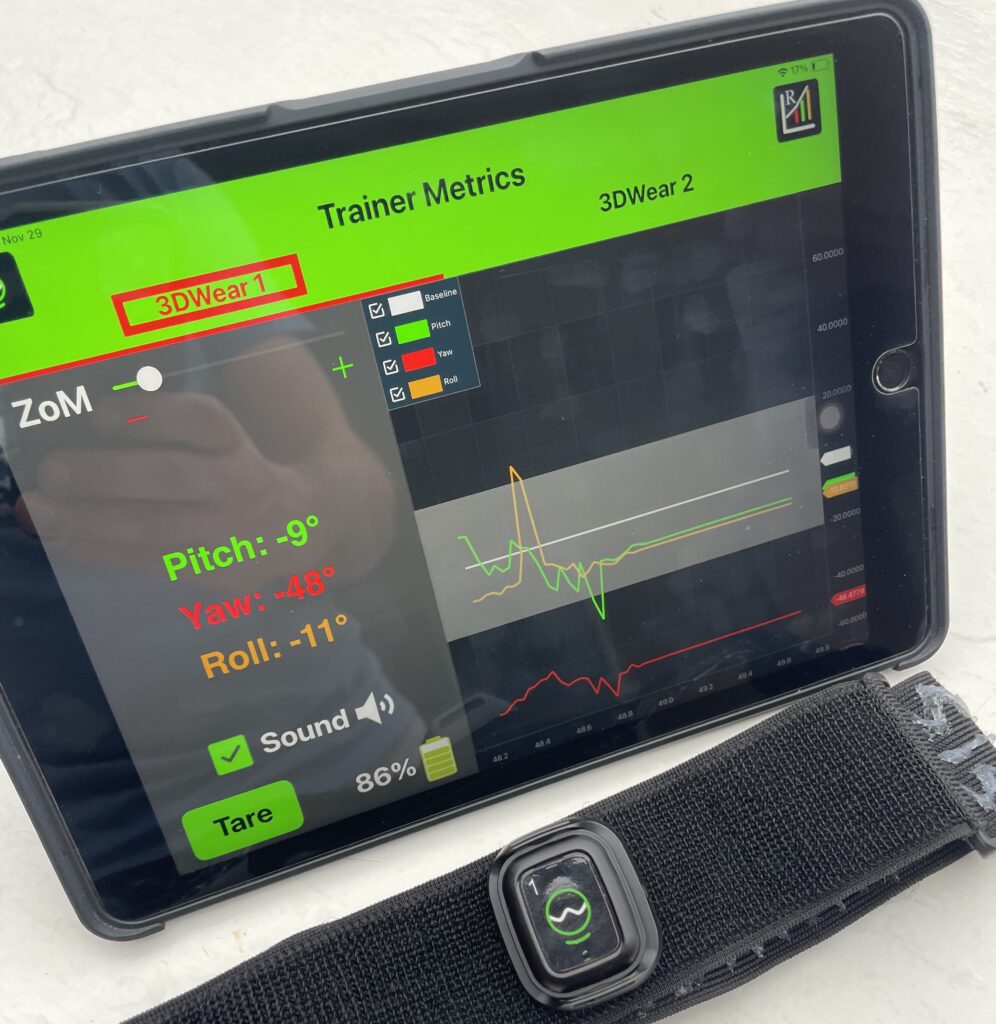
Eddie can imagine having an aero position motion mapped for when the bike is up to speed and the rider benefits from being in the aero bars, as well as having a climbing motion mapped when the bike is at a lower speed going uphill and the rider benefits from sitting upright in the bull horns. The 3DWearable system would know based on speed and grade which set of motions was ideal for each scenario and would cue the athlete to adjust to the ideal baseline motion for each scenario.
The possibilities are endless, and 3DWearable has identified several user groups that would benefit from their system, including golf; cycling; walking/running/hiking; strength training; target sports like archery and shooting; racket sports; and skiing.
Early Adopters
3DWearable is offering limited quantities of the system to early adopters at a reduced price. The 3DWearable team will be in close communication with the early adopters to coach them through how to apply the sensors and use the system to map and track motion. As the company scales the system and number of users, they intend on offering more instructional video content through their application.
The sensors have an 8-hour battery life and are rechargeable. The application is available for both Apple iOS and Android devices.
The introductory reduced price is $799 for two sensors, or $399 for a single sensor, and the app with no subscription fee for cloud storage for the first year. If you are interested, visit them at 3DWearable.org or e-mail them at info@3DWearable.org.
Eddie O’Dea will also answer your questions in the forum.
Tags:
3D WearableBike FitTrainingContinue the discussion at forum.slowtwitch.com
3 more replies
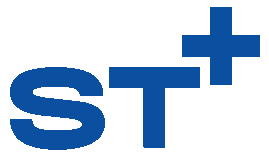
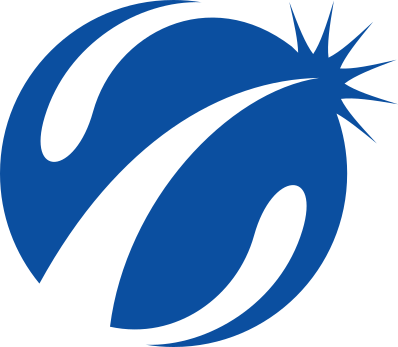


How does this differ from the Leomo system? Seems pretty similar.
I appreciate that it took effort to identify and describe this product, whose objective - pose tracking in the wild - is one of considerable interest to many triathletes. I mean this constructively, that I’m surprised to see hardware-based (i.e. joint-sensor) ‘new’ technology for tracking human body pose for general AG athletes. In fact, after the aero article and mention of the difficulty in getting the right static image, I almost suggested just getting some video - it doesn’t even need to be perfect side view, especially if you have rigid parts to reference (like the bike!).
There are a variety of single-view video pose estimators already available, and there are already human skeleton 3D models (which you technically don’t need, but can offer faster generalization to new, untrained videos). Many of these come from the research community and so are freely available.
There are some aspects of kinematics that direct sensors will be superior for, and it’s still more straightforward to have direct IMUs /position transmitters on board and recording, for use cases of changing posture that require continuous monitoring. But for a triathlete’s movements, we’re mostly about pose so that we can check bike fit. And having videos set up during rides (possibly even on-board) could get a lot - not all - but a lot of what’s being described here, and without fiddly hardware=more futureproof.
I do understand the benefit of having a realtime feedback system continuously monitoring, which would apply to video in an indoor setting only. So I’m not saying there’s no use case, only that the technology is somewhat self-limiting already. The good news is, if they develop strong software for the feedback and UI, they could grow into video based and other modalities as inputs on the back end. I look forward to seeing where this goes.
I should probably say, I have nothing to disclose - I do not own any part of any company, IP, etc. related to this. I have used IMUS and video for pose estimation and keep somewhat up with the field, is all.
One specific request: please for the love of all that is sacred, I’m begging you, drop the “neuro re-education” mumbo jumbo. It’s training. You’re training posture, pose, and coordination. There are no CME credits for neurons. Thank you. And good luck!
Thank you for the feedback. It sure did take some effort. We came into this as a bike fitters, coaches, and athletes and that formed our take on why this tech was needed.
Who determines the ‘ideal’ position and what proof exists that this really is ideal?
[quote=“eddie3D, post:5, topic:1283704, full:true”]
Thank you for the feedback. It sure did take some effort. We came into this as a bike fitters, coaches, and athletes and that formed our take on why this tech was needed.
-That was what I figured. So, I’m hoping to keep this constructive. I think your heart is in the right place.
1. Video is useful, but not enough. Video cannot track the minutia happening on the inside. Even the best set up with a video only system cannot track the small effects that say 2 mm in saddle height can change. …If your saddle is too high, you will rock. If your saddle is too low you will rock… Video cannot measure this.
3. Video does not work well in the real world. Small changes in the throw or the angle in relationship to the subject can skew the angles one is viewing. I’m not saying video isn’t a useful tool, but optical illusions are just that…illusions.
6. I think I’ve already addressed the “self limiting” part of our tech. … Having a tool that can track your movements and go with you everywhere is the challenge 3DWearable is trying to overcome. We have bettered what video can do already and we see a path to even more improvement with both our product and your athletic endeavors in the not so distant future.
-Although the wearable solution is arguably klunky, we don’t have video monitoring everywhere outdoors yet, AFAIK! I can very much see how your wearables could be beneficial outside, for continuous monitoring. And I would completely buy into the argument that these real-world positions don’t look like the indoors positions, and may only happen in specific situations that your continuous monitoring can capture (e.g. after 3 hours outside on the bike, or after getting out of the saddle on a climb, etc.) I know my position changes outdoors unlike indoors, but I don’t know e.g. if it’s less aero or powerful, or what I would need to do to my bike fit to better accommodate the posture my body is trying to adopt. Love the tech for this!
8. Having the feedback in real time all of the time is a game changer. Changing the way we move is a huge challenge. Try learning to run backwards or writing with your opposing hand. Habits are incredibly useful, but also hard to change. That’s what coaching is all about. Most AG athletes don’t have a coach with them on every training session.
AGREED!
10. Our apologizes for the big words. We have been bridging between the complicated world of understanding human bodies and how they move through the world (kinematics) and explaining it on many levels for so long that eventually the big words slip out. It’s a long and complicated path to learning new motor skills and changing habits. Neuro reeducation is not just mumbo jumbo to us. It’s what we do every day. It’s what every athlete does every second they are training and in some cases even when they are not “training.” Rather than use the term less we want to see it used every day. It’s a term that should be in every athletes’ and coaches’ daily lives.
Brave of you to open yourself up to public scrutiny on a forum like this. A couple questions if you don’t mind:
What IMU manufacturer are you using for the device and which validation studies would you point to representing its tracking accuracy?
What parameters are you using to calculate joint centre locations based on boney landmarks? I’m assuming it’s De lava but those parameters are struggling with single digit count IMU systems rather than full boney landmark motion capture.
How involved with practitioners are you planning on being to make sure they are able properly palpate/place a sensor on the correct landmarks?
What angles are you reporting to practitioners? Are they 3D? 2D Sagittal? Sagittal with a transverse offset?
As others have mentioned, where do your guidelines for fits come from?
Cost? Per unit? Subscription based? Software costs?